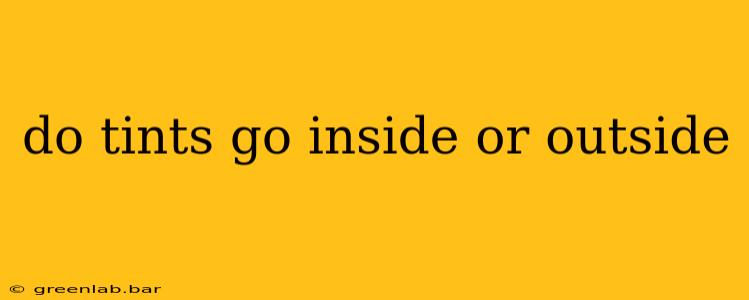Window tinting offers numerous benefits, from increased privacy and reduced glare to enhanced fuel efficiency and UV protection. But a common question arises: should the tint be applied to the inside or the outside of your windows? The answer, while seemingly simple, depends on several factors and understanding the implications of each placement is crucial for maximizing your investment and achieving the desired outcome.
Inside vs. Outside Tint: A Detailed Comparison
The overwhelming consensus among professional installers and automotive experts points towards inside application as the superior and most common method for window tinting. Here's why:
Advantages of Inside Window Tint:
-
Protection from the Elements: Exterior tint is constantly exposed to the elements – sun, rain, snow, ice, and debris from the road. This exposure leads to faster degradation, scratching, and fading. Inside tint is shielded from these harsh conditions, extending its lifespan significantly.
-
Easier Installation and Removal: Applying tint to the interior of the glass is generally easier and less prone to errors. Removal is also simpler and less likely to damage the window itself.
-
Better Adhesion: Interior application often results in better adhesion, reducing the chances of peeling or bubbling. This is because the interior surface of the glass is usually smoother than the exterior, which can sometimes have imperfections or coatings.
-
Warranty Considerations: Most reputable tint manufacturers offer warranties specifically for interior applications. Exterior tint warranties are less common due to the increased risk of damage from external factors.
-
Enhanced Safety: In the event of shattered glass, inside tint will help hold the fragments together, reducing the risk of injury.
Disadvantages of Inside Window Tint:
- Slightly Reduced Visibility at Night (Depending on the Tint): Darker tints can slightly reduce nighttime visibility, although advancements in film technology are continuously mitigating this issue.
Advantages of Outside Window Tint (Rarely Used):
- Potentially Higher Heat Rejection (In Specific Cases): Some specialized films might offer marginally better heat rejection when applied externally, but this advantage is often negligible compared to the drawbacks.
Disadvantages of Outside Window Tint:
-
Rapid Degradation: As previously mentioned, exterior tint is much more susceptible to damage and fading, drastically shortening its lifespan.
-
Difficult Installation and Removal: Applying and removing exterior tint is far more challenging and requires specialized skills and tools.
-
Increased Risk of Damage: The exterior application is vulnerable to scratches, chips, and other forms of damage.
-
Legal Considerations: Many jurisdictions have regulations regarding window tint that might specifically prohibit exterior application.
Choosing the Right Tint: Beyond Inside vs. Outside
The placement of the tint is only one aspect to consider. Other important factors include:
-
Tint Darkness (VLT): Visible Light Transmission (VLT) refers to how much light passes through the tint. Regulations regarding VLT vary by location, so check your local laws before making a decision.
-
Type of Film: Different films offer varying levels of heat rejection, UV protection, and glare reduction. Ceramic films are generally preferred for their superior heat rejection properties.
Conclusion:
For the vast majority of applications, applying window tint to the inside of the window is the recommended approach. It offers superior longevity, easier installation, better adhesion, and greater protection from the elements. While exterior application may offer a very slight edge in some specific heat-rejection scenarios, these gains are drastically overshadowed by the numerous drawbacks. Always consult with a professional window tinting installer to determine the best solution for your specific needs and local regulations.

